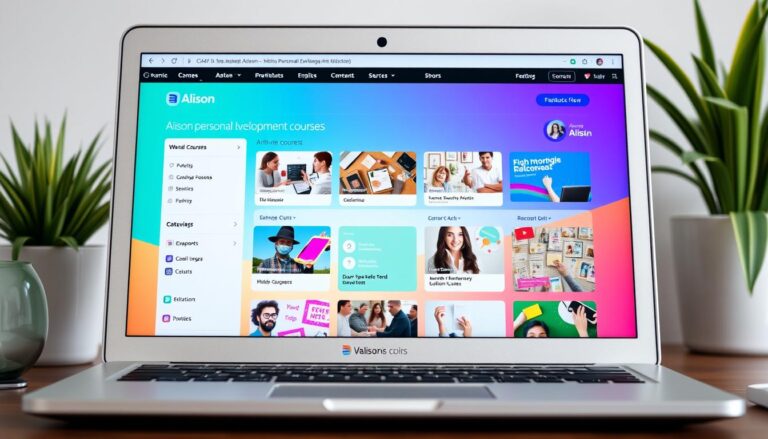Learn Spanish Conversation with These Top Courses
Are you eager to learn a new language and connect with millions of Spanish speakers worldwide? Mastering conversational Spanish can be a game-changer, whether you’re planning a trip, expanding your business, or simply exploring a new culture.
We’ve discovered that effective language learning goes beyond traditional grammar-focused lessons. It’s about practice and immersion in real-world conversations.
Our comprehensive guide explores the most effective courses that cater to learners at all levels, providing lessons that focus on conversational skills and practical grammar usage.
Key Takeaways
- Discover the top courses for learning conversational Spanish.
- Understand what makes a great Spanish conversation course.
- Learn how to choose a course that matches your learning style.
- Explore both free and paid course options with detailed pros and cons.
- Improve your Spanish conversation skills with confidence.
Why Conversational Spanish Skills Matter
Developing conversational skills in Spanish is crucial for anyone looking to truly connect with the language and its culture. While textbooks and language learning apps can provide a foundation in grammar and vocabulary, they often fall short in preparing learners for real-world conversations.
Conversing in Spanish is not just about stringing words together; it’s about understanding the nuances of the language and the cultural context in which it’s spoken. By engaging in conversations, learners can gain a more nuanced understanding of the Spanish language, including its idioms, expressions, and cultural references.
Beyond Vocabulary: The Importance of Real-World Practice
Real-world practice is essential for mastering conversational Spanish. Conversation is the gateway to understanding cultural nuances that textbooks simply cannot convey. Through conversation, learners can develop a more authentic accent and improve their comprehension of different Spanish dialects. Different Spanish-speaking regions have unique expressions and cultural references that you’ll only learn through conversation.
- Learning conversational Spanish helps you connect with native speakers on a deeper level, building meaningful relationships.
- Mastering conversational skills allows you to participate in social situations rather than just observing from the sidelines.
Cultural Connection Through Conversation
The Spanish language contains cultural values and perspectives that become apparent when engaging in natural dialogue. Understanding humor, slang, and colloquialisms is essential for truly connecting with Spanish speakers and their culture. We’ve discovered that students who engage in regular conversations develop greater cultural sensitivity and appreciation. By learning conversational Spanish, you’re not just learning a language; you’re gaining a window into a different culture.
In conclusion, conversational Spanish skills matter because they enable learners to engage fully with the language and its culture. By prioritizing conversational practice, learners can develop a more nuanced understanding of the Spanish language and build meaningful connections with native speakers.
What Makes a Great Spanish Conversation Course
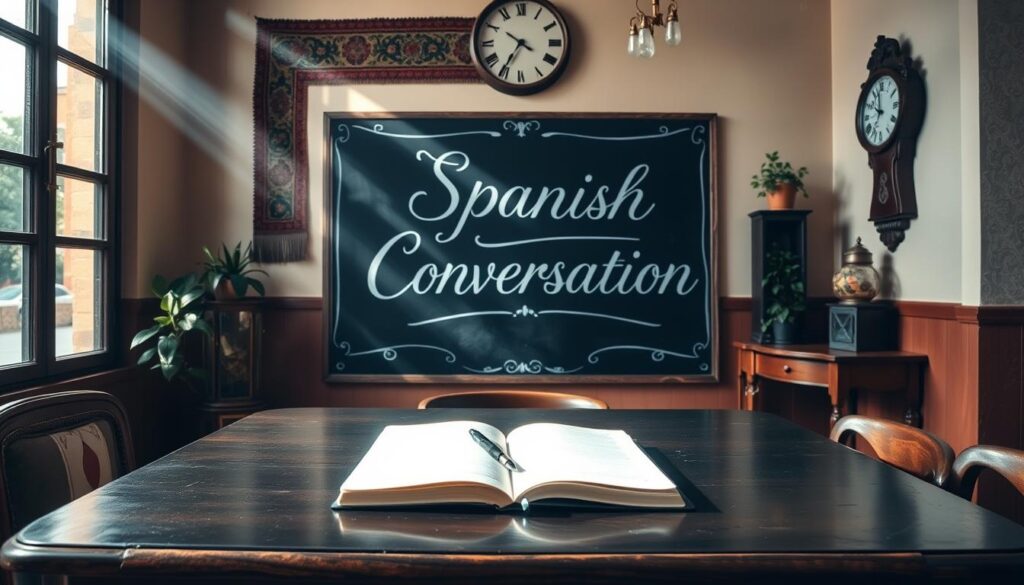
A great Spanish conversation course is defined by its ability to provide practical speaking opportunities. When evaluating various courses, we look for specific features that distinguish exceptional learning experiences from mediocre ones.
Interactive Speaking Opportunities
Interactive speaking opportunities are crucial in a Spanish conversation course. The best courses incorporate regular speaking practice, allowing learners to apply their knowledge in real-time conversations. This interactive approach helps build confidence and fluency.
Some key aspects we look for include:
- Opportunities for learners to engage in conversations with native speakers or tutors
- Use of interactive tools and technologies to facilitate speaking practice
- Regular feedback and assessment to improve pronunciation and comprehension
Native Speaker Exposure
Exposure to native speakers is another vital component of an effective Spanish conversation course. Listening to and interacting with native speakers helps learners develop authentic pronunciation, intonation, and comprehension skills.
We evaluate whether lessons include:
- Audio or video recordings featuring native speakers
- Opportunities for learners to practice speaking with native speakers or language exchange partners
- Cultural insights and nuances that native speakers can provide
Practical Scenarios and Dialogues
Practical scenarios and dialogues are essential in teaching conversational Spanish. The most effective courses focus on everyday situations and thematic lessons, rather than abstract grammar concepts. This approach helps learners acquire relevant vocabulary and phrases that they can use in real-life situations.
Key characteristics include:
- Dialogues that progress from basic to complex conversations
- Use of current and relevant vocabularyand expressions
- Emphasis on appropriate formal and informal speech for different social contexts
How We Evaluated These Spanish Conversation Courses
To identify top-notch Spanish conversation courses, we employed a rigorous testing methodology. Our evaluation process was designed to assess the effectiveness of each course in developing practical conversation skills.
Our Testing Methodology
We tested each course by engaging with their lessons and evaluating the overall learning experience. Our primary focus was on how well the courses facilitated practice and improved conversational proficiency. We assessed the quality of the content and the variety of learning activities offered. The frequency and quality of speaking practice opportunities were also crucial in our assessment.
We observed that the best courses provided a balance between guided lessons and opportunities for free practice. This balance allowed learners to both grasp the fundamentals and apply their knowledge in real-world scenarios.
Criteria for Selection
Our primary selection criterion was how effectively each course develops practical, usable conversation skills rather than just theoretical knowledge. We evaluated the quality and authenticity of conversational content, prioritizing natural dialogues over scripted, artificial exchanges.
- The varietyof learning activities offered to accommodate different learning preferences was a key consideration.
- We considered the balance between guided lessonsand opportunities for free practicein each course.
- The frequency and quality of speaking practiceopportunities heavily influenced our ratings.
- Value for money was an important consideration – we looked for courses that deliver results proportionate to their cost.
| Evaluation Criteria | Description | Importance |
|---|---|---|
| Practical Conversation Skills | Development of usable conversation skills | High |
| Authenticity of Content | Quality and naturalness of conversational content | High |
| Variety of Learning Activities | Range of activities to suit different learning styles | Medium |
| Value for Money | Results delivered in proportion to the course cost | Medium |
Best Spanish Conversation Courses for Different Learning Styles

The key to successful Spanish conversation skills lies in finding a course that caters to your individual learning style. Different learners benefit from different approaches, whether it’s through visual, auditory, or interactive methods.
Visual Learners
Visual learners benefit from courses that incorporate images, videos, and other visual aids to facilitate learning. These courses often include lessons with infographics, videos, and interactive captions that help learners understand and retain new vocabulary and grammar. We recommend courses that provide a variety of visual content to keep learners engaged.
Some courses use interactive videos that allow learners to practice their conversation skills in context. These videos often include branching narratives or scenario-based conversations that challenge learners to make decisions and respond accordingly.
Audio-Focused Learners
For those who learn best through listening, audio-focused courses offer a range of lessons that emphasize listening and speaking skills. These courses often include audio recordings of native speakers, podcasts, or even audiobooks that learners can listen to and repeat.
Audio-focused courses also provide opportunities for learners to practice their pronunciation and intonation. By listening to native speakers and mimicking their speech patterns, learners can improve their overall conversation skills.
Interactive Learners
Interactive learners thrive in environments that offer immediate feedback and frequent opportunities for engagement. We recommend courses with gamified elements that make conversation practice feel rewarding and entertaining.
- Courses that include role-playing scenarios with branching dialogue options
- Courses that incorporate speech recognition technology for immediate pronunciation feedback
- Courses that facilitate language exchange with native speakers
- Courses with a varietyof interactive exercises to maintain motivation
By choosing a course that aligns with your learning style, you can maximize your progress and achieve your Spanish conversation goals.
Duolingo: Free Spanish Learning with Gamification
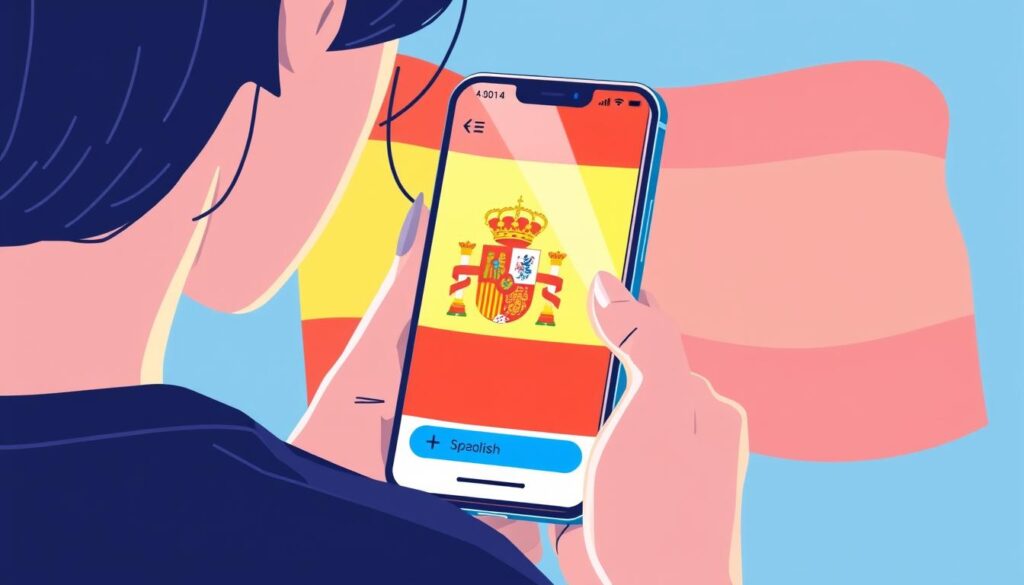
Duolingo has revolutionized the way people learn Spanish with its gamified approach. This popular language-learning platform has made it possible for anyone to start learning Spanish from scratch, all for free.
Overview
Duolingo is an innovative language-learning tool that uses gamification to make learning Spanish fun and engaging. It’s designed for beginners, offering a structured introduction to Spanish grammar and vocabulary. The course is accessible, allowing users to practice daily and build a consistent learning habit.
Pros
Duolingo’s Spanish course has several advantages. It’s ideal for:
- Absolute beginners who need a structured introduction to Spanish.
- Casual learners who prefer short, game-like practice sessions.
- Visual learners who benefit from the colorful interface and gamified elements.
- Budget-conscious learners who can’t afford paid courses.
Cons
While Duolingo is a valuable tool, it has its drawbacks. It doesn’t teach particularly practical language from the outset, and it lacks a focus on speaking skills. Some users might find the content too methodical and slow-paced.
Best For
Duolingo is best suited for:
- Those who are new to Spanish and need a foundational course.
- Learners who enjoy gamified learning experiences.
- Individuals looking for a supplementary resource to enhance their learning.
FluentU: Learning Through Authentic Spanish Media

Discover the power of authentic Spanish media with FluentU’s cutting-edge learning platform. FluentU brings real-world Spanish content to your fingertips, making the learning process engaging and effective.
Overview
FluentU is an innovative language learning platform that uses authentic Spanish videos, including movie trailers, music videos, and news clips, to help learners improve their Spanish skills. The platform works by providing interactive subtitles, quizzes, and exercises tailored to the learner’s level. With FluentU, learners can watch authentic Spanish content with interactive captions, making it easier to understand and remember new vocabulary and phrases.
Pros
FluentU has several advantages that make it stand out. It’s ideal for visual learners who retain information better through engaging video content. The platform is also exceptionally well-suited for intermediate level students who have basic grammar but need exposure to authentic speech. Additionally, FluentU’s content is entertaining, making it perfect for learners who get bored with traditional textbook approaches.
Some key benefits include improving listening comprehension, expanding vocabulary, and understanding Spanish as it’s spoken in media and everyday life. It’s also an excellent supplementary resource for students already taking conversation classes.
Cons
While FluentU is a powerful tool, it’s not without its drawbacks. Some learners might find the content overwhelming due to the vast amount of available videos. Additionally, while the platform is generally user-friendly, some users might require time to get accustomed to the interface.
Best For
FluentU is best for several types of learners. It’s ideal for visual learners and those at an intermediate level looking to enhance their Spanish skills. It’s also perfect for learners seeking an engaging, non-traditional learning experience. Additionally, self-directed learners who prefer exploring topics of personal interest will find FluentU valuable.
BaseLang’s Real World Program: Unlimited One-on-One Tutoring
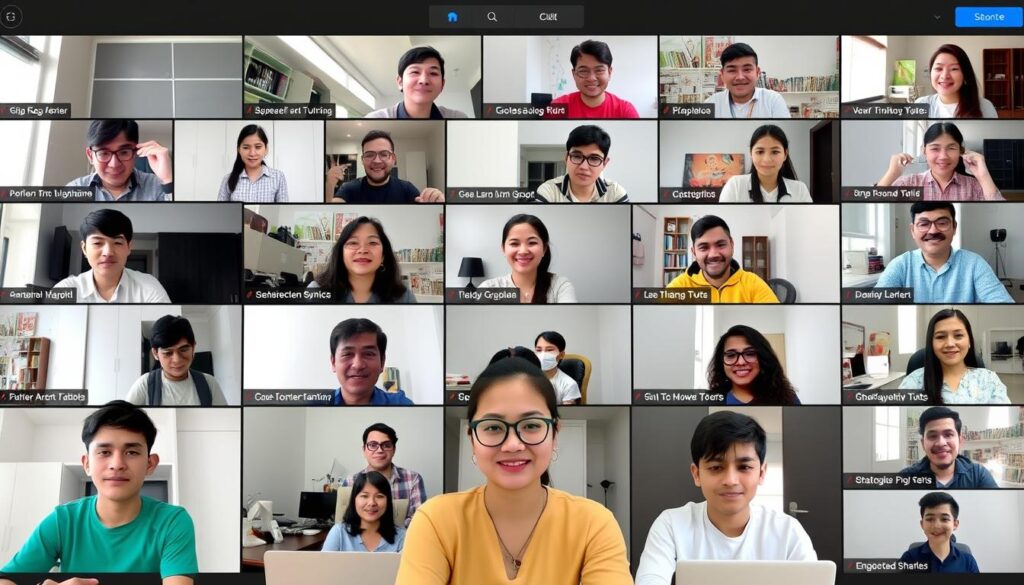
If you’re looking to immerse yourself in Spanish, BaseLang’s Real World Program is a standout option with its unlimited one-on-one tutoring. This program is designed to propel learners from zero to conversational fluency efficiently.
Overview
BaseLang offers a subscription-based model that grants access to unlimited one-on-one online Spanish conversation tutoring. With a pool of over 100 tutors, learners can choose their preferred tutor or switch as needed. The program promises to deliver fast and efficient progress, allowing learners to dictate their pace and schedule. Additionally, BaseLang provides class materials at no extra cost.
Pros
BaseLang is ideal for motivated learners seeking conversational fluency quickly. It’s perfect for those who thrive in direct interaction rather than self-study. The program is also beneficial for individuals preparing for travel or relocation to Spanish-speaking countries, professionals needing Spanish for work, and extroverted learners who energize through conversation.
Cons
While BaseLang offers a flexible and efficient learning path, the cost might be a consideration for some. Learners must also be self-motivated to maintain consistent practice outside of tutoring sessions.
Best For
BaseLang is worth the investment for anyone valuing their time and seeking an efficient path to speaking Spanish. It’s particularly suited for individuals who require flexible scheduling, such as professionals, and those who benefit from structured learning and accountability.
Spanish for Beginners: Learn Conversational Spanish Quickly

For those new to Spanish, a well-structured course is essential for building a strong foundation. The SkillSuccess Spanish conversation course is designed specifically for beginners, offering a comprehensive introduction to conversational Spanish.
Overview
The SkillSuccess Spanish conversation course covers several key topics, including common verbs, present tense conjugations, negation, questions, greetings, and more. This course provides a solid foundation for beginners to start their Spanish learning journey.
With a focus on practical conversational skills, the course is ideal for those who want to learn Spanish quickly and effectively.
Pros
The SkillSuccess Spanish conversation course has several advantages.
- It’s perfect for self-directed learners who prefer to work through material at their own pace.
- Visual learners will benefit from seeing instructors demonstrate proper pronunciation.
- Budget-conscious learners will appreciate the affordable one-time payment for lifetime access.
Additionally, the course is suitable for busy professionals who need flexible learning options, thanks to its concise, focused lessons.
Cons
While the SkillSuccess Spanish conversation course offers many benefits, there are some potential drawbacks to consider.
- Some learners may find the lack of interactive elements or community support to be a limitation.
- The course may not be suitable for advanced learners or those seeking specialized knowledge.
Best For
This course is ideal for true beginners who want to learn Spanish conversation skills from scratch. It’s also suitable for those who want a structured introduction to Spanish before attempting real-world conversations, and for busy professionals who need flexible learning options.
Additionally, it’s excellent for those who want to build a foundation of conversational Spanish before traveling.
The Conversational Spanish Rapid-Learning Method

For those looking to quickly learn practical Spanish, the Conversational Spanish Rapid-Learning Method is a standout choice. This course is designed to help learners achieve fluency in a short amount of time, making it ideal for individuals with busy schedules.
Overview
The Conversational Spanish Rapid-Learning Method on Udemy is a comprehensive spanish course that focuses on practical conversation skills. To further reinforce your learning, the course also offers practice videos, quizzes, and PDF printouts. This multifaceted approach ensures that learners are well-rounded in their ability to understand and communicate in Spanish.
Pros
This course is ideal for various types of learners, including: – Travelers who want to learn practical Spanish quickly before visiting Spanish-speaking countries. – Pragmatic learners who prioritize communication over perfect grammatical accuracy. – Busy individuals who need functional Spanish without extensive grammar study. – Visual and auditory learners who benefit from seeing and hearing conversations demonstrated. The course’s practical approach makes it an excellent choice for those who have tried traditional methods without success.
Cons
While the course excels in many areas, it may not be suitable for those seeking an in-depth understanding of Spanish grammar. Learners who prefer a more traditional or structured approach might find the rapid-learning method challenging to adapt to. Additionally, the time required to achieve fluency can vary significantly among learners.
Best For
This course is perfect for: – Business travelers needing specific situational Spanish for professional interactions. – Individuals focusing on speaking Spanish rather than reading or writing it. The Conversational Spanish Rapid-Learning Method is an excellent choice for anyone looking to learn Spanish quickly and effectively, especially those who value practical conversation skills.
One Month Spanish: 30-Day Conversation Program
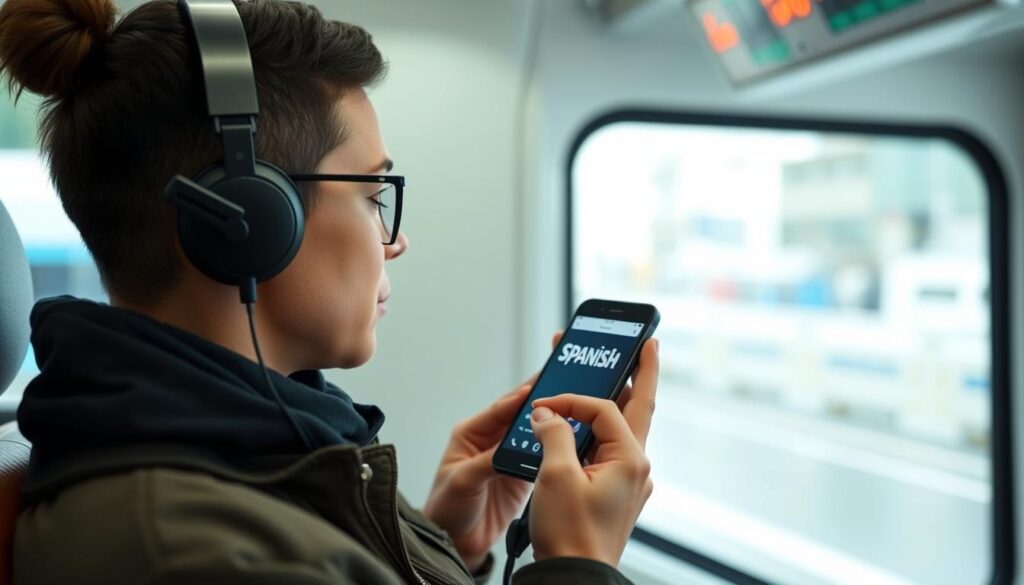
The One Month Spanish program is a rigorous 30-day online course that focuses on teaching conversational Spanish through daily audio lessons. This course is designed to immerse learners in the language, focusing on speaking and listening skills rather than traditional methods like studying flashcards and grammar rules.
Overview
This online course is structured to teach conversational Spanish in just 30 days, with a new audio lesson each day. The topics covered are diverse and practical, including greetings and introductions, looking for an apartment, sightseeing, and more. By focusing on audio learning, the course caters to learners who prefer absorbing information through listening.
The course’s structure is ideal for those who thrive under a defined timeline, making it perfect for motivated learners and busy professionals who can incorporate daily audio lessons into their routines.
Pros
The One Month Spanish course has several advantages. It’s ideal for auditory learners who retain information best through listening and speaking. The daily lessons provide a structured program that keeps learners on track, making it excellent for those who have struggled with maintaining momentum in other courses. Additionally, the focus on conversational skills makes it particularly useful for travelers preparing for a trip to a Spanish-speaking country.
Other benefits include its suitability for busy professionals and pragmatic learners focused on functional conversation skills. The course’s clear daily objectives help learners stay motivated and engaged throughout the 30-day period.
Cons
While the One Month Spanish course offers many benefits, it may not be suitable for everyone. Learners who prefer a more flexible schedule might find the daily lesson commitment challenging. Additionally, those who rely heavily on visual learning methods might need to supplement this course with additional resources.
Moreover, the intensive nature of the course requires consistent effort and dedication, which can be daunting for some learners.
Best For
One Month Spanish is best suited for motivated learners who thrive under the pressure of a defined timeline. It’s perfect for auditory learners, busy professionals, and travelers preparing for a trip. If you’re looking for a structured program with clear daily objectives, this course is an excellent choice. It’s also ideal for pragmatic learners focused on functional conversation skills rather than academic language study.
Spanish Dialogues by 123TeachMe: Free Conversation Practice

For those seeking to improve their Spanish conversation skills, 123TeachMe offers a valuable resource with its Spanish Dialogues. This free resource is designed to provide learners with authentic listening practice and exposure to various Spanish accents and regional variations.
Overview
123TeachMe’s Spanish Dialogues cover a wide range of topics and grammar levels, from basic to advanced. You’ll find hundreds of dialogues covering specific grammar topics, such as the present tense, verb gustar, imperfect subjunctive, and impersonal se. The dialogues are designed to help learners improve their listening comprehension and pronunciation.
Pros
Authentic Listening Practice: The dialogues provide real-life conversational scenarios, helping learners get used to how Spanish is spoken in everyday situations. Diverse Accents and Regional Variations: Exposure to different accents and regional variations helps learners understand Spanish as it’s spoken across various countries.
The resource is ideal for self-directed learners, those who prefer example-based learning, and intermediate learners looking to improve their listening skills. It’s also budget-friendly, with comprehensive free content available without subscription requirements.
Cons
While 123TeachMe’s Spanish Dialogues are a valuable resource, they might not provide explicit grammar instruction. Some learners may find it challenging to understand certain dialogues due to varying accents or regional expressions.
Best For
Spanish Dialogues by 123TeachMe is best suited for: – Self-directed learners seeking authentic listening practice. – Learners who benefit from example-based learning approaches. – Intermediate learners aiming to improve their listening comprehension. – Budget-conscious learners looking for free, high-quality content. – Those who want to practice specific conversational scenarios or improve their pronunciation by mimicking native speakers.
Camino Barcelona Conversation Spanish Courses

Immerse yourself in Spanish culture and language with Camino Barcelona’s expert-led conversation courses. Camino Barcelona is renowned for its comprehensive approach to language learning, offering a structured environment that fosters rapid progress.
Overview
Camino Barcelona’s conversation Spanish courses are designed to cater to diverse learning needs. With a focus on interactive lessons, the school provides an immersive experience that goes beyond traditional classroom learning. The curriculum is carefully crafted to include two different conversation topics each day, Monday through Friday, for all 52 weeks of the year, ensuring a rich and varied learning experience.
Pros
The strengths of Camino Barcelona’s program include its accredited courses, taught by expert teachers who bring real-world experience into the classroom. The lessons are designed to be engaging and challenging, with a focus on practical conversation skills. Learners benefit from a structured learning environment that promotes steady progress.
Key benefits include: – Ideal for serious learners seeking accredited Spanish instruction. – Perfect for those who can travel to Barcelona and wish to combine language learning with cultural immersion. – Suitable for students who thrive in structured classroom environments. – Offers a social learning experience with opportunities to practice with classmates. – Excellent for those preparing for official Spanish examinations. – Valuable for professionals needing documented, accredited Spanish language training.
Cons
While Camino Barcelona offers a robust learning experience, it’s essential to consider that the program is location-dependent, requiring students to be in Barcelona. This might limit accessibility for some potential learners.
Best For
Camino Barcelona’s Spanish courses are best suited for individuals who value professional instruction and are looking for a comprehensive learning experience. This includes serious learners, professionals requiring accredited training, and those who can immerse themselves in the language by being in Barcelona.
Specialized Spanish Conversation Courses
Whether you’re in healthcare or business, there are Spanish conversation courses designed to meet your professional needs. These specialized courses focus on developing the specific language skills required for different industries.
Spanish for Healthcare Settings
Rice University offers a conversation course tailored for healthcare professionals. This course is divided into four modules, each focusing on a different aspect of patient-doctor interaction. The course is designed to be completed at your own pace, requiring at least 23 hours to finish. It includes videos, readings, and assignments, all conducted in Spanish at an intermediate level. You will also need to complete a test at the end of each section to assess your understanding.

Business Spanish Conversation Courses
Business Spanish conversation courses are designed to enhance professional vocabulary and communication skills in workplace settings. These courses cover a range of topics including negotiations, presentations, email writing, and professional networking in Spanish. Many programs incorporate role-playing exercises to simulate common business scenarios, such as meetings and interviews. The curriculum often includes cultural training on business etiquette in different Spanish-speaking countries, ensuring that professionals can navigate international business environments effectively.
- Cover topics like negotiations and presentations
- Include role-playing exercises for realistic practice
- Offer cultural training on business etiquette
- Often incorporate authentic business materials
- Require at least intermediate Spanish proficiency

By focusing on the specific needs of different professions, these specialized Spanish conversation courses provide learners with the practical skills and cultural understanding necessary to succeed in their chosen field.
Free vs. Paid Spanish Conversation Resources
The decision to opt for free or paid Spanish conversation resources depends on several factors, including learning goals and personal preferences. When considering the best approach, it’s essential to weigh the benefits of each option.
What You Get with Free Options
Free Spanish conversation resources, such as Duolingo and Spanish Dialogues by 123TeachMe, offer a range of lessons and interactive exercises. These resources are ideal for beginners or those on a tight budget. However, they often lack the personalized feedback that is crucial for improving pronunciation and grammar usage.
Some benefits of free resources include:
- Accessibility: Free resources are available to anyone with an internet connection.
- Flexibility: Learners can practice at their own pace and convenience.
- Community support: Many free resources have active communities that provide support and motivation.
When It’s Worth Paying for Premium Courses
Premium Spanish conversation courses offer several advantages, including access to professional teachers and tutors who provide personalized feedback. Paid options like BaseLang offer unlimited access to native-speaking tutors for consistent conversation practice.
The benefits of paid courses include:
- Personalized feedback: Professional teachers can identify and correct fossilized errors.
- Structured curriculum: Ensures comprehensive coverage of conversational abilities.
- Accountability features: Increases completion rates and consistent practice.
- Specialized content: Courses tailored to specific fields, such as business or healthcare, justify their cost through targeted content.
How to Maximize Your Spanish Conversation Practice

To get the most out of your Spanish learning journey, it’s crucial to maximize your conversation practice. Maximizing conversation practice involves combining various learning strategies and being consistent.
Combining Courses with Language Exchange
Combining a Spanish course with language exchange opportunities can significantly enhance your learning experience. By enrolling in a structured course, you gain access to a curriculum that is designed to progressively improve your language skills. Simultaneously, participating in language exchange programs allows you to apply what you’ve learned in real-life conversations.
As emphasized by a language learning expert,
“The key to language acquisition is not just understanding the rules, but being able to use them in context.”
This underscores the importance of combining theoretical knowledge with practical application.
Creating a Consistent Practice Schedule
To make consistent progress in your Spanish learning journey, establishing a regular practice schedule is vital. Here are some strategies to help you stay on track:
- Establish a realistic weekly schedule that includes both course lessons and conversation practice sessions.
- Opt for short, daily practice sessions (15-30 minutes) rather than infrequent, long study sessions.
- Utilize time-blocking to protect your Spanish practice time from being overtaken by other commitments.
- Create a dedicated learning environment that is free from distractions.
- Track your practice consistency using habit-tracking apps or journals.
- Incorporate Spanish into your daily routines, such as narrating your day or thinking aloud while cooking.
- Set specific, measurable conversation goals for each week.
- Build rewards into your practice schedule to celebrate your progress.
By implementing these strategies, you can create an effective Spanish conversation practice routine that complements your learning style and goals. Consistency is key to making progress in language learning.
As you continue on your Spanish learning journey, remember that every bit of practice counts, and staying committed will yield significant improvements over time.
Conclusion: Finding Your Ideal Spanish Conversation Course
The journey to mastering Spanish conversation skills is highly personal, and the right course is one that aligns with your unique objectives and learning preferences. As we’ve explored various options, it’s clear that the ideal Spanish conversation course depends on several factors, including your learning style, goals, and available time commitment.
When selecting a course, consider your primary motivation for learning Spanish conversation skills. Are you preparing for travel, work, or personal enrichment? This will help you determine whether you need structured guidance or prefer self-directed learning. Be realistic about your budget; while premium courses offer advantages, free or low-cost options can be effective when used consistently.
Remember, conversation skills develop through practice, so prioritize lessons that provide ample speaking opportunities. You may want to start with a free option to establish habits before investing in premium courses. The most effective approach often combines multiple resources, such as a structured course supplemented with language exchange practice.
Ultimately, the best Spanish conversation course is one that you’ll actually use consistently over time. We recommend testing several options through free trials or introductory lessons before committing to a particular program. Whichever course you choose, success depends more on your consistent practice than on the specific program features.
By considering these factors and being committed to regular language learning, you’ll be well on your way to improving your Spanish conversation skills.







